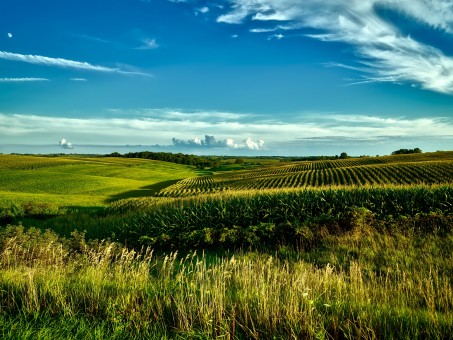Agricultural Aid Promised in Response to Covid-19, Little Available Right Now.

The water remains murky when it comes to COVID-19 relief for farmers. The US Department of Agriculture’s plans around the $9.5 Billion earmarked for agricultural producers in the Coronavirus Aid, Relief and Economic Security Act (CARES) passed on March 27, 2020 are still to be announced. There are some rumors an announcement will be coming soon.
In addition livestock markets are being hit hard at a time when many ranchers and farmers would sell their calf crop. The frustration compounds when producers see the increase in prices for meat paid by consumers. SD Senator Mike Rounds said, “The reality is there’s an inverse correlation between the producer’s price and the consumer’s price. If the Department of Justice finds no violations, then the statutory environment of the industry must be reconsidered because the status quo isn’t working.”
Rounds announced a three-part plan that includes immediate relief for cattle producers who are being “unfairly harmed” by COVID-19 market disruption, supporting efforts to reinstate mandatory Country Of Origin Labeling (COOL), and urging a federal investigation into allegations of anti-trust violations by meatpackers.
There are a lot of people telling farmers and ranchers help is coming. The problem is it’s very unclear what that help will look like. So the rest of this article looks at what we know about programs currently available to farmers and ranchers.
The debate of the moment revolves around two Small Business Administration (SBA) programs: the Payroll Protection Program (P3) and the Economic Injury Disaster Loan Grant (EIDL).
Payroll Protection Program
Small Businesses, self-employed individuals, independent contractors, and sole-proprietors, including farms and ranches, with less than 500 employees are eligible for the P3 program.
Current reports are being circulated that the P3 program is out of funds allocated from the CARES Act, however additional funds for this program are a part of negotiations going on in Washington right now.
The loan can be used to cover payroll costs, mortgage interest, rent, and utility costs over the 8 week period after the loan is made. Payroll costs include salaries, employee benefits, and payroll taxes. Ranchers, farmers and other small businesses with employees can apply for PPP loans through existing SBA lenders, or through any federally insured depository institution or credit union, and Farm Credit System Institutions.
P3 loans are capped at $10 million, and can cover up to two months of a business’s average monthly payroll costs (plus an additional 25 percent for non-payroll expenses). Although the payment is made as a loan, any loan proceeds that a business uses to cover payroll costs, mortgage interest, rent, and utilities during the eight-week period after the loan is made can be forgivable. However, this forgivable amount will be reduced if businesses don’t maintain full-time employees (as of February 2020); decrease salaries or wages by more than 25 percent, or spend more than 25 percent of the loan on non-payroll costs.
Economic Injury Disaster Loan Grant
Currently the Small Business Administration (SBA) does not offer the EIDL Grant to ranchers or farmers. The CARES Act provided $10 billion to expand SBA’s EIDL program by adding emergency grants of up to $10,000 that do not need to be repaid. Efforts are being made to change the SBA’s exemption excluding ranchers and farmers from accessing this program.
For more information on these SBA programs visit NSAC’s blog post on the subject: https://sustainableagriculture.net/blog/confusion-remains-over-sba-assistance-farmers/
Unemployment
Self-employed people experiencing unemployment due to COVID-19 may be eligible for unemployment, this includes farmers and ranchers who have lost specific markets due to the virus. For example farmers who sell produce to restaurants who have closed due to the virus or sell to farmers markets that aren’t opening may be eligible for unemployment benefits.
The South Dakota Department of Labor is currently not accepting applications from self employed people although they are developing an application process. https://dlr.sd.gov/ra/cares.aspx
Right now there is little guidance from the US Secretary of Labor as to agricultural situations will be eligible for unemployment assistance. In addition to those examples above, situations like dairy producers unable to deliver milk, cattle producers who lost a significant amount of money on spring calf sales or livestock producers unable to market due to plant closures should also be eligible for this assistance.
It appears, without this guidance from the Federal Government and once applications are being accepted, it will be up to the application processor to decide if a situation qualifies. These decisions can be appealed.
In addition pressure can be put on our Congressional Delegation and the Secretary of Labor to give clear guidance that includes the common agricultural situations.
It also needs to be noted that if income is only deferred the unemployment assistance may need to be paid back and benefits are taxable.
The amount of your benefits are based upon your income in 2019. If you had no income or declared a loss the base benefit is the state average of $172/week. In addition the CARES Act allows for an additional $600/week. The program provides up to 39 weeks of benefits.
For more information about these programs and for helpful updates and blog posts checkout Farm Common’s resource page.
Also Farmers Legal Action Group just released a comprehensive guide to Covid-19 relief. A downloadable copy can be found here: http://www.flaginc.org/wp-content/uploads/2020/04/Farmers-Guide-to-COVID-19-Relief-April-2020.pdf
Also stay tuned to Dakota Rural Action’s website “News” tab as we will update you as soon as we can with additional information about programs as they become available.
